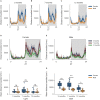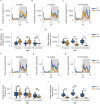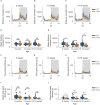Longitudinal home-cage automated assessment of climbing behavior shows sexual dimorphism and aging-related decrease in C57BL/6J healthy mice and allows early detection of motor impairment in the N171-82Q mouse model of Huntington's disease
- PMID: 37035623
- PMCID: PMC10073658
- DOI: 10.3389/fnbeh.2023.1148172
Longitudinal home-cage automated assessment of climbing behavior shows sexual dimorphism and aging-related decrease in C57BL/6J healthy mice and allows early detection of motor impairment in the N171-82Q mouse model of Huntington's disease
Abstract
Monitoring the activity of mice within their home cage is proving to be a powerful tool for revealing subtle and early-onset phenotypes in mouse models. Video-tracking, in particular, lends itself to automated machine-learning technologies that have the potential to improve the manual annotations carried out by humans. This type of recording and analysis is particularly powerful in objective phenotyping, monitoring behaviors with no experimenter intervention. Automated home-cage testing allows the recording of non-evoked voluntary behaviors, which do not require any contact with the animal or exposure to specialist equipment. By avoiding stress deriving from handling, this approach, on the one hand, increases the welfare of experimental animals and, on the other hand, increases the reliability of results excluding confounding effects of stress on behavior. In this study, we show that the monitoring of climbing on the wire cage lid of a standard individually ventilated cage (IVC) yields reproducible data reflecting complex phenotypes of individual mouse inbred strains and of a widely used model of neurodegeneration, the N171-82Q mouse model of Huntington's disease (HD). Measurements in the home-cage environment allowed for the collection of comprehensive motor activity data, which revealed sexual dimorphism, daily biphasic changes, and aging-related decrease in healthy C57BL/6J mice. Furthermore, home-cage recording of climbing allowed early detection of motor impairment in the N171-82Q HD mouse model. Integrating cage-floor activity with cage-lid activity (climbing) has the potential to greatly enhance the characterization of mouse strains, detecting early and subtle signs of disease and increasing reproducibility in preclinical studies.
Keywords: Huntington’s disease (HD); automated; digital biomarkers; motor function; neurodegeneration; reproducible; welfare.
Copyright © 2023 Bains, Forrest, Sillito, Armstrong, Stewart, Nolan and Wells.
Conflict of interest statement
RS and JA were employed by and were shareholders in Actual Analytics Ltd at the time the research was performed and therefore declare a competing financial interest. Actual HCA is commercially available from Actual Analytics Ltd. The remaining authors declare that the research was conducted in the absence of any commercial or financial relationships that could be construed as a potential conflict of interest.
Figures




Similar articles
-
An Automated Home-Cage System to Assess Learning and Performance of a Skilled Motor Task in a Mouse Model of Huntington's Disease.eNeuro. 2017 Sep 18;4(5):ENEURO.0141-17.2017. doi: 10.1523/ENEURO.0141-17.2017. eCollection 2017 Sep-Oct. eNeuro. 2017. PMID: 28929129 Free PMC article.
-
Altered selenium status in Huntington's disease: neuroprotection by selenite in the N171-82Q mouse model.Neurobiol Dis. 2014 Nov;71:34-42. doi: 10.1016/j.nbd.2014.06.022. Epub 2014 Jul 8. Neurobiol Dis. 2014. PMID: 25014023
-
An open system for automatic home-cage behavioral analysis and its application to male and female mouse models of Huntington's disease.Behav Brain Res. 2012 Apr 1;229(1):216-25. doi: 10.1016/j.bbr.2012.01.015. Epub 2012 Jan 13. Behav Brain Res. 2012. PMID: 22266926
-
IntelliCage: the development and perspectives of a mouse- and user-friendly automated behavioral test system.Front Behav Neurosci. 2024 Jan 3;17:1270538. doi: 10.3389/fnbeh.2023.1270538. eCollection 2023. Front Behav Neurosci. 2024. PMID: 38235003 Free PMC article. Review.
-
Three Pillars of Automated Home-Cage Phenotyping of Mice: Novel Findings, Refinement, and Reproducibility Based on Literature and Experience.Front Behav Neurosci. 2020 Oct 30;14:575434. doi: 10.3389/fnbeh.2020.575434. eCollection 2020. Front Behav Neurosci. 2020. PMID: 33192366 Free PMC article. Review.
Cited by
-
Clinicopathologic Dissociation: Robust Lafora Body Accumulation in Malin KO Mice Without Observable Changes in Home-Cage Behavior.J Comp Neurol. 2024 Jul;532(7):e25660. doi: 10.1002/cne.25660. J Comp Neurol. 2024. PMID: 39039998 Free PMC article.
-
Of Mice and Mates: Automated Classification and Modelling of Mouse Behaviour in Groups Using a Single Model Across Cages.Int J Comput Vis. 2024;132(12):5491-5513. doi: 10.1007/s11263-024-02118-3. Epub 2024 Jun 17. Int J Comput Vis. 2024. PMID: 39554493 Free PMC article.
-
Modelling POLG mutations in mice unravels a critical role of POLγΒ in regulating phenotypic severity.Nat Commun. 2025 May 23;16(1):4782. doi: 10.1038/s41467-025-60059-y. Nat Commun. 2025. PMID: 40404629 Free PMC article.
-
Automated home cage monitoring of an aging colony of mice-Implications for welfare monitoring and experimentation.Front Neurosci. 2024 Oct 29;18:1489308. doi: 10.3389/fnins.2024.1489308. eCollection 2024. Front Neurosci. 2024. PMID: 39534023 Free PMC article.
References
-
- Bains R. S., Cater H. L., Sillito R. R., Chartsias A., Sneddon D., Concas D., et al. . (2016). Analysis of individual mouse activity in group housed animals of different inbred strains using a novel automated home cage analysis system. Front. Behav. Neurosci. 10, 1–12. 10.3389/fnbeh.2016.00106 - DOI - PMC - PubMed
-
- Baran S. W., Bratcher N., Dennis J., Gaburro S., Karlsson E. M., Maguire S., et al. . (2022). Emerging role of translational digital biomarkers within home cage monitoring technologies in preclinical drug discovery and development. Front. Behav. Neurosci. 15:758274. 10.3389/fnbeh.2021.758274 - DOI - PMC - PubMed
LinkOut - more resources
Full Text Sources
Molecular Biology Databases

